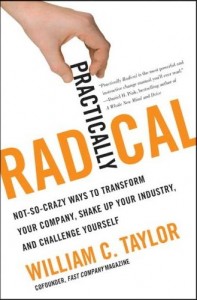By Marylene Delbourg-Delphis
 Practically Radical, by Bill Taylor, the co-founder of Fast Company, is about transforming your company, shaking up your industry, and challenging yourself. Now, where do you start? Not from a vacuum: the times for dreams of starting from a clean slate and building up utopias are long gone. So, be practical. Yet adopting a middle-of-the-road approach can only make you shrivel up into mediocrity. So, be radical, i.e. proceed from what the roots of your company are, from the raison-d’être of what your industry is, and find the wellspring of all information – others. Everything is here, around you, for you to reinvent yourself as an innovative executive, as a purpose-driven entrepreneur, as a movement leader. In a nutshell, be practically radical, i.e, find solutions. Taylor quite relevantly reminds us of one of the best Clintonian piece of advice: “There is nothing wrong with America that cannot be cured by what is right with America.”
Practically Radical, by Bill Taylor, the co-founder of Fast Company, is about transforming your company, shaking up your industry, and challenging yourself. Now, where do you start? Not from a vacuum: the times for dreams of starting from a clean slate and building up utopias are long gone. So, be practical. Yet adopting a middle-of-the-road approach can only make you shrivel up into mediocrity. So, be radical, i.e. proceed from what the roots of your company are, from the raison-d’être of what your industry is, and find the wellspring of all information – others. Everything is here, around you, for you to reinvent yourself as an innovative executive, as a purpose-driven entrepreneur, as a movement leader. In a nutshell, be practically radical, i.e, find solutions. Taylor quite relevantly reminds us of one of the best Clintonian piece of advice: “There is nothing wrong with America that cannot be cured by what is right with America.”
While the notion of “disruption” remains a pervasive marketing catchword, what I like most in this book is the idea that innovation stems from what I would call “constructive subversion,” which was also the underlying theme of Mavericks at Work that Taylor co-authored with Polly LaBarre. When the know-it-alls perceive the world from their allegedly expert standpoint, they show a strong propensity to downgrade novelty into a French expression, calling it “déja vu.” Creative minds reverse perspectives and look at a familiar situation as if they had never seen it before. They experience the “Vujà dé,” “a strange term” Taylor says, that may be attributed to various people (he mentions Tom Kelley, Bob Sutton and George Carlin). It refers to the old rhetorical device of re-arranging syllables of a word or words in a sentence (metathesis) that French people ultimately named verlan in 1950, and that became the language of the immigrants and the working class of the Parisian suburbs.
So, regardless of any former experience, become an immigrant within your own turf: what you will see will shape how you change, and where you will look will shape what you see. You will make Providence (RI) a safer place with Dean Esserman, rejuvenate the Swiss Swiss watch manufacturing industry as did Lebanese Nicolas Hayek who co-founded the Swatch Group – while resurrecting Omega – or redefine the standards of service for Internet retail (even those of you who believe you know everything about Tony Hsieh, read Taylor‘s visit to Zappos‘ headquarters as a … cevino – verlan for novice). The language of innovation recombines known syllables to create new emotions: “the most enduring source of competitive advantage is for emotionally charged employees to capture the emotionally drained customers.”
This book is remarkably well organized in three sections (transforming your company, shaking up your industry, and challenging yourself), each subdivided into three chapters, with each ending chapter reading as a collection of five takeaways: Five truths of corporate transformation, Five new rules for starting something new, Five habits of highly humbitious leaders. Each section can be read independently. Yet, albeit permitting an à la carte study, the entire book is compelling because of the underlying consistency of the message. Will you ever be able to transform your company or shake up an industry if you have all the answers? At best, you will just be a prefab manager in a prefab company in a prefab world speaking a prefab language in the midst of prefab people living their prefab lives… You will never even think of the hidden geniuses around you or around the world at large, and you will never have the “million-dollar idea to attract ideas” that enabled Reed Hastings of Netflix to improve the company’s recommendation engine by an order of magnitude. “The real genius of leadership today is knowing how to move forward when you and your senior colleagues don’t have all the answers — devising ways to uncover the most powerful ideas in the most unexpected places, even if those ideas come from outside the organization.”
So, be ambitious, yet remain humble, and become “humbitious,” and look at your company as a community where “everyone is in charge.” Tellingly enough, the penultimate chapter of the book ends with the Threadless phenomenon. Ultimately, modern leaders could be imaginative curators who make everybody shine.

0 responses so far ↓
There are no comments yet...Kick things off by filling out the form below.
Leave a Comment